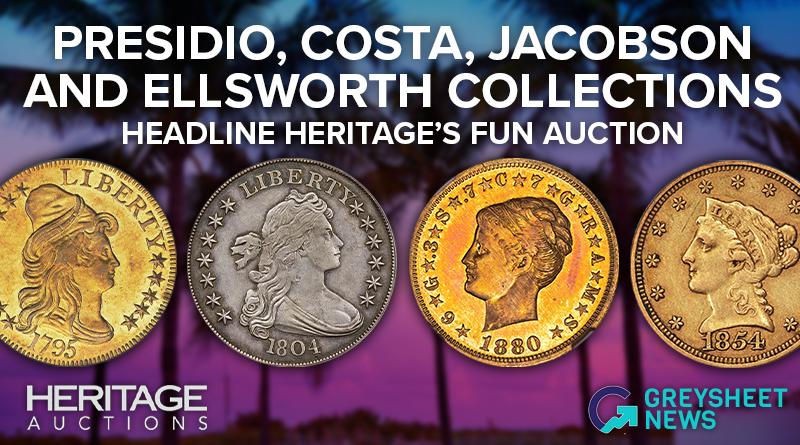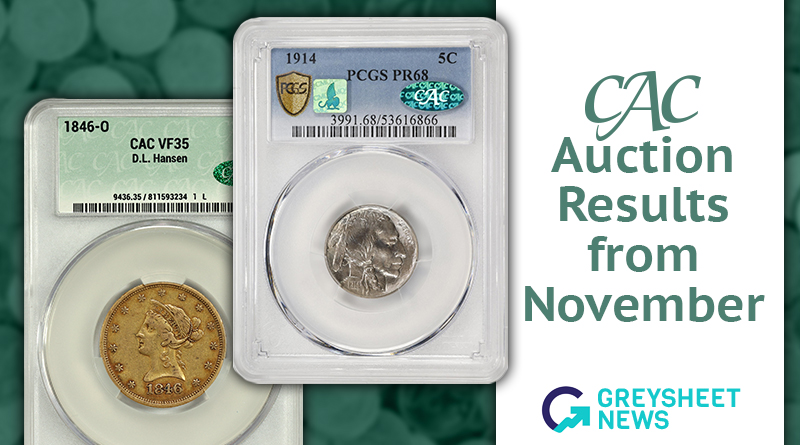Greysheet & CPG® PRICE GUIDE
- U.S. Coins /
- Pattern Coinage /
-
1859 Pattern Values
About This Series
History and Overview
After 1858, the Flying Eagle cent was discontinued for regular circulation use, and in 1859, the Indian Head motif was adopted, descending from the pattern issues of 1858, specifically J-208. The Indian Head style would be used through 1909, modified slightly along the way. The reverse for the 1859 cent illustrates the “laurel” or “olive” (Mint correspondence used both terms) wreath earlier used on 1858 patterns. The motif proved to be excellent for striking the coins up properly as the high-relief Indian Head at the center was opposite the dies from the laurel wreath on the reverse.
Several interesting varieties of pattern Indian Head cents were made in 1859, the most famous being J-228, a transitional issue, probably struck to the extent of over a thousand pieces, nearly all in circulation format, creating pieces seen today in Mint State (not Proof). The reverse featured a new design, an oak wreath with a narrow shield at the top, which was subsequently used for regular coinage beginning in 1860, continuing until 1909. These pieces may have been struck for circulation, but in small quantities.1
In the silver half dime series, a few transitional pieces were struck combining the regular Liberty Seated die of 1859, with stars, with a reverse die of 1860 with the inscription HALF DIME within an agricultural wreath.2 This particular coin did not include the inscription UNITED STATES OF AMERICA, and therefore a “stateless” coin was created, one of many in the pattern series.3 A related pattern was struck in 1860 (J-267). Transitional 1859 dimes were also made in the same “stateless” format.
Pattern quarter dollars combined a regular 1859 die with the Paquet reverse die used in 1858 to strike J-221.
Most activity in the pattern series in 1859 was concentrated on the half dollar denomination, mostly from new dies distinctive in their appearance. Two obverse dies were made, one by Longacre and the other by Paquet. Three reverse dies employed what Mint Director James Ross Snowden called Harold P. Newlin’s ‘“Wreath of Cereals,’ composed of cotton, tobacco, sugar cane, com, wheat, and oak leaves, which was deliberately designed to admit perfect striking of the head on the obverse.” Another reverse was cut by Paquet and was described as having “the American eagle, with its wings expanded in flight, grasping an olive branch in a scroll, inscribed E PLURIBUS UNUM. Upon its breast is suspended the United States shield. Legend, UNITED STATES OF AMERICA. . . . HALF DOLLAR.”4
Half Dollar Obverse Dies of 1859
Obverse 1: “Paquet’s Seated Liberty with fasces.” • Used with J-235, J-236, J-247 to J-253.
Obverse 2: “Longacre’s French Liberty Head.” • Used with J-237 to J-246, J-253.
Half Dollar Reverse Dies of 1859
Reverse A: “Paquet’s perched eagle, perfect ribbon.” • Employed in 1858 with J-222. Used with 1859-dated dies with J-235, J-236, J-245, J-246.
Reverse B: “Paquet’s perched eagle, broken ribbon.” • Used with a rusted 1838 die to strike J-75a and J-75b. Used with 1859-dated dies to restrike J-235, J-236, J-245, J-246.
Reverse C: ‘“Cereal wreath’ enclosing inscription HALF DOLLAR.” • Used with J-237, J-238, J-247, J-248.
Reverse D: “‘Cereal wreath’ enclosing inscription 1/2 DOLLAR.” • Used with J-239 to J-240b, J-249, J-250.
Reverse E: “‘Cereal wreath’ enclosing 50 CENTS.” • Used with J-241, J-242, J-251, J-252.
Reverse F: “Regular half dollar reverse of this year.” • Used with J-243, J-244.
Somewhat similar to the pattern cents of 1858, the pattern half dollars of 1859 provided a rich opportunity for Mint officials to make interesting combinations, restrikes, and other pieces for collectors. In general, the dies for half dollars of this year were not highly polished, and most of them show significant parallel raised marks or striae. In time, certain of the dies, particularly Reverse B, deteriorated and were heavily relapped. Curiously, certain 1838 pattern half dollars (J-75a and J-75b) were struck from this deteriorated die. The actual time of manufacture was likely in the 1870s.
Of special historic and numismatic importance is the $20 known as J-260, employing a new die by Anthony C. Paquet, appropriately called the “Paquet Reverse,” similar to the regular issue, but with UNITED STATES OF AMERICA / TWENTY D in very tall letters. From 1859 to 1861 several die varieties of the Paquet Reverse were made and used in 1860 to coin J-272a and J-273 and later to coin the regular-issue 1861 Paquet Reverse and 1861-S Paquet Reverse double eagles, the first being an extreme rarity (just two are known) and the last being a well-known scarce variety (several hundred are known).
Collecting Perspective
Among the pattern coins of 1859, the transitional Indian Head cent (J-228) is a collector’s favorite. Most known examples are in gem Mint State. Hundreds exist, but it is still several times rarer than an 1856 Flying Eagle cent, another transitional pattern. The good news is that, unlike the latter, the 1859 is not listed in A Guide Book of United States Coins. Otherwise, it would become so popular that it would cost tens of thousands of dollars!
Half dollars of 1859 furnish a veritable playground for study and collecting, somewhat similar in this respect to the pattern cents of 1858. In general, most numismatists aspire to obtain the four most readily available varieties, these being J-235 and J-236 (silver and copper), J-237 and J-238, J-239 and J-240, and J-241 and J-242. Accomplishing this is easy enough. The die surfaces are often incompletely polished and irregular. Copper strikings are apt to be dull, cleaned, and otherwise unsatisfactory, and to find choice pieces requires extensive searching, perhaps viewing a half dozen to find one with at least a small degree of eye appeal.
Paquet’s ungainly pattern double eagle, J-257, appears with some frequency, usually with unsatisfactory fields, somewhat porous or granular. This is true of regular copper pieces as well as those that are gilt.
Catalog Detail
Legal Disclaimer
The prices listed in our database are intended to be used as an indication only. Users are strongly encouraged to seek multiple sources of pricing before making a final determination of value. CDN Publishing is not responsible for typographical or database-related errors. Your use of this site indicates full acceptance of these terms.

















From the Greysheet Marketplace
Buy Now: $3,695.00
Buy Now: $2,890.63
Buy Now: $120,000.00
Buy Now: $38,900.00
Buy Now: $5,500.00
Buy Now: $37,000.00
Buy Now: $3,121.88
Buy Now: $37,000.00
Buy Now: $31,500.00
Buy Now: $125,000.00
Related Stories (powered by Greysheet News)
View all news
Greysheet Catalog Details
History and Overview
After 1858, the Flying Eagle cent was discontinued for regular circulation use, and in 1859, the Indian Head motif was adopted, descending from the pattern issues of 1858, specifically J-208. The Indian Head style would be used through 1909, modified slightly along the way. The reverse for the 1859 cent illustrates the “laurel” or “olive” (Mint correspondence used both terms) wreath earlier used on 1858 patterns. The motif proved to be excellent for striking the coins up properly as the high-relief Indian Head at the center was opposite the dies from the laurel wreath on the reverse.
Several interesting varieties of pattern Indian Head cents were made in 1859, the most famous being J-228, a transitional issue, probably struck to the extent of over a thousand pieces, nearly all in circulation format, creating pieces seen today in Mint State (not Proof). The reverse featured a new design, an oak wreath with a narrow shield at the top, which was subsequently used for regular coinage beginning in 1860, continuing until 1909. These pieces may have been struck for circulation, but in small quantities.1
In the silver half dime series, a few transitional pieces were struck combining the regular Liberty Seated die of 1859, with stars, with a reverse die of 1860 with the inscription HALF DIME within an agricultural wreath.2 This particular coin did not include the inscription UNITED STATES OF AMERICA, and therefore a “stateless” coin was created, one of many in the pattern series.3 A related pattern was struck in 1860 (J-267). Transitional 1859 dimes were also made in the same “stateless” format.
Pattern quarter dollars combined a regular 1859 die with the Paquet reverse die used in 1858 to strike J-221.
Most activity in the pattern series in 1859 was concentrated on the half dollar denomination, mostly from new dies distinctive in their appearance. Two obverse dies were made, one by Longacre and the other by Paquet. Three reverse dies employed what Mint Director James Ross Snowden called Harold P. Newlin’s ‘“Wreath of Cereals,’ composed of cotton, tobacco, sugar cane, com, wheat, and oak leaves, which was deliberately designed to admit perfect striking of the head on the obverse.” Another reverse was cut by Paquet and was described as having “the American eagle, with its wings expanded in flight, grasping an olive branch in a scroll, inscribed E PLURIBUS UNUM. Upon its breast is suspended the United States shield. Legend, UNITED STATES OF AMERICA. . . . HALF DOLLAR.”4
Half Dollar Obverse Dies of 1859
Obverse 1: “Paquet’s Seated Liberty with fasces.” • Used with J-235, J-236, J-247 to J-253.
Obverse 2: “Longacre’s French Liberty Head.” • Used with J-237 to J-246, J-253.
Half Dollar Reverse Dies of 1859
Reverse A: “Paquet’s perched eagle, perfect ribbon.” • Employed in 1858 with J-222. Used with 1859-dated dies with J-235, J-236, J-245, J-246.
Reverse B: “Paquet’s perched eagle, broken ribbon.” • Used with a rusted 1838 die to strike J-75a and J-75b. Used with 1859-dated dies to restrike J-235, J-236, J-245, J-246.
Reverse C: ‘“Cereal wreath’ enclosing inscription HALF DOLLAR.” • Used with J-237, J-238, J-247, J-248.
Reverse D: “‘Cereal wreath’ enclosing inscription 1/2 DOLLAR.” • Used with J-239 to J-240b, J-249, J-250.
Reverse E: “‘Cereal wreath’ enclosing 50 CENTS.” • Used with J-241, J-242, J-251, J-252.
Reverse F: “Regular half dollar reverse of this year.” • Used with J-243, J-244.
Somewhat similar to the pattern cents of 1858, the pattern half dollars of 1859 provided a rich opportunity for Mint officials to make interesting combinations, restrikes, and other pieces for collectors. In general, the dies for half dollars of this year were not highly polished, and most of them show significant parallel raised marks or striae. In time, certain of the dies, particularly Reverse B, deteriorated and were heavily relapped. Curiously, certain 1838 pattern half dollars (J-75a and J-75b) were struck from this deteriorated die. The actual time of manufacture was likely in the 1870s.
Of special historic and numismatic importance is the $20 known as J-260, employing a new die by Anthony C. Paquet, appropriately called the “Paquet Reverse,” similar to the regular issue, but with UNITED STATES OF AMERICA / TWENTY D in very tall letters. From 1859 to 1861 several die varieties of the Paquet Reverse were made and used in 1860 to coin J-272a and J-273 and later to coin the regular-issue 1861 Paquet Reverse and 1861-S Paquet Reverse double eagles, the first being an extreme rarity (just two are known) and the last being a well-known scarce variety (several hundred are known).
Collecting Perspective
Among the pattern coins of 1859, the transitional Indian Head cent (J-228) is a collector’s favorite. Most known examples are in gem Mint State. Hundreds exist, but it is still several times rarer than an 1856 Flying Eagle cent, another transitional pattern. The good news is that, unlike the latter, the 1859 is not listed in A Guide Book of United States Coins. Otherwise, it would become so popular that it would cost tens of thousands of dollars!
Half dollars of 1859 furnish a veritable playground for study and collecting, somewhat similar in this respect to the pattern cents of 1858. In general, most numismatists aspire to obtain the four most readily available varieties, these being J-235 and J-236 (silver and copper), J-237 and J-238, J-239 and J-240, and J-241 and J-242. Accomplishing this is easy enough. The die surfaces are often incompletely polished and irregular. Copper strikings are apt to be dull, cleaned, and otherwise unsatisfactory, and to find choice pieces requires extensive searching, perhaps viewing a half dozen to find one with at least a small degree of eye appeal.
Paquet’s ungainly pattern double eagle, J-257, appears with some frequency, usually with unsatisfactory fields, somewhat porous or granular. This is true of regular copper pieces as well as those that are gilt.
Catalog Detail
Legal Disclaimer
The prices listed in our database are intended to be used as an indication only. Users are strongly encouraged to seek multiple sources of pricing before making a final determination of value. CDN Publishing is not responsible for typographical or database-related errors. Your use of this site indicates full acceptance of these terms.










 Loading more ...
Loading more ...











